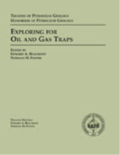Difference between revisions of "Predicting carbonate porosity and permeability"
Jump to navigation
Jump to search
(Initial import) |
m (link) |
||
| Line 20: | Line 20: | ||
* [[Carbonate diagenetic stages]] | * [[Carbonate diagenetic stages]] | ||
* [[Early carbonate diagenesis]] | * [[Early carbonate diagenesis]] | ||
| − | * [[Basics of carbonate | + | * [[Basics of carbonate porosity formation and preservation]] |
* [[Sea level cycles and carbonate sequences]] | * [[Sea level cycles and carbonate sequences]] | ||
* [[Sea level cycles and carbonate diagenesis]] | * [[Sea level cycles and carbonate diagenesis]] | ||
Revision as of 17:43, 6 February 2014
| Exploring for Oil and Gas Traps | |

| |
| Series | Treatise in Petroleum Geology |
|---|---|
| Part | Predicting the occurrence of oil and gas traps |
| Chapter | Predicting reservoir system quality and performance |
| Author | Dan J. Hartmann, Edward A. Beaumont |
| Link | Web page |
| Store | AAPG Store |
Predicting reservoir quality in carbonate rocks can be difficult because of the complexity of their pore systems. Applying a combination of concepts of depositional environment, diagenesis, and sequence stratigraphy increases the chances of predicting the quality of reservoir needed for a successful play. Sequence stratigraphic models are especially useful for modeling pore-space evolution and enhance prediction of the location and quality of potential carbonate reservoir rocks.
See also
- Carbonate facies
- Carbonate diagenetic stages
- Early carbonate diagenesis
- Basics of carbonate porosity formation and preservation
- Sea level cycles and carbonate sequences
- Sea level cycles and carbonate diagenesis
- Sea level cycles and climate
- Sequences during low-amplitude, high-frequency cycles
- Sequences during moderate-amplitude, high-frequency cycles
- Sequences during high-amplitude, high-frequency cycles
- Predicting carbonate reservoir location and quality